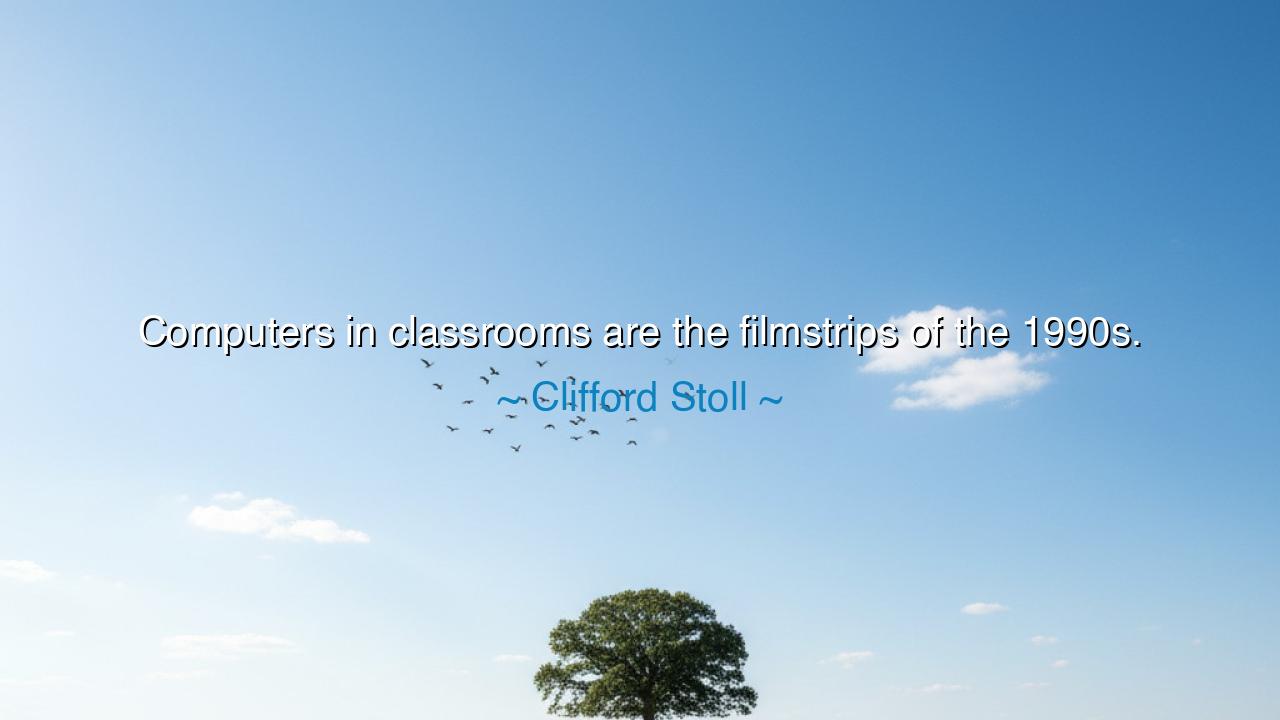
Computers in classrooms are the filmstrips of the 1990s.






Clifford Stoll’s words, “Computers in classrooms are the filmstrips of the 1990s,” strike at the heart of a profound critique of how technology can sometimes be overhyped, yet underutilized. In this simple but evocative statement, Stoll compares the computer—a tool lauded for its potential to revolutionize education—to the filmstrips of the past, which were once heralded as the future of learning but quickly faded into obsolescence. His words are a warning about the dangers of adopting technology without purpose and intent, relying on it as a trend rather than a transformational tool. Like the filmstrips of the 20th century, computers in classrooms, while once thought of as revolutionary, may become just another fad if they are not properly integrated into the educational experience.
In the ancient world, tools and inventions were revered, but they were never seen as the end-all solution to human advancement. Take, for example, the Greeks, who believed that knowledge could only truly flourish through critical thinking and dialogue. Socrates did not rely on written texts or mechanical devices to teach; instead, he engaged his students in the Socratic method—an exchange of questions and answers that fostered deep reflection and the development of wisdom. Similarly, Plato argued that true education was not about absorbing facts but about developing the mind to think independently and to question assumptions. This timeless approach to learning reminds us that while tools can enhance our learning, they must be secondary to the development of human insight.
The filmstrips of the past were initially seen as a breakthrough in education, a way to bring visual learning into the classroom and make abstract concepts more tangible. However, filmstrips were limited—they lacked interaction, depth, and engagement. They were static images and one-directional presentations. Over time, they were replaced by more dynamic and interactive technologies, like video tapes, television broadcasts, and ultimately, computers. Stoll’s comparison between computers and filmstrips is a sharp critique of how, despite their potential, new technologies can be reduced to empty tools unless they are used to actively engage and empower learners. The tool is not the end, but rather the means to a deeper, more profound learning experience.
Consider the example of Leonardo da Vinci, whose genius was not merely in the tools he used but in the way he engaged with the world around him. He didn’t rely on the machine of his time to innovate; rather, his curiosity, his ability to observe, and his deep understanding of nature were the true drivers of his discoveries. His notebooks are filled with ideas about anatomy, engineering, and flight—none of which were made possible by mechanical devices alone. Da Vinci’s work was about using his mind to transcend the limitations of his tools, and this is the key lesson Stoll’s quote conveys: technology, while powerful, should never replace thought, creativity, or critical engagement.
When computers were first introduced into classrooms, there was immense hope that they would revolutionize education—offering instant access to information, interactive learning environments, and global collaboration. However, the reality, as Stoll suggests, is that computers in many classrooms became little more than a digital version of the filmstrip—tools used in ways that were superficial rather than transformative. Teachers, instead of using the computers to foster critical thinking and engagement, often resorted to using them as overhead projectors for static lessons. This use of technology, disconnected from its true potential, mirrored the filmstrips of the past—novel and exciting at first, but ultimately lacking in depth and meaning.
In contrast, there are examples of schools and educators who have used computers and technology to truly transform learning. The Flipped Classroom model, where students engage with learning material at home through interactive platforms, leaving class time for collaborative problem-solving, is a prime example of how technology can empower students. Innovative platforms like Khan Academy, which provide customized learning experiences, show the potential of technology to not only support, but enhance, the human learning process. The key lies not in the computer itself, but in how we use it—whether it is a tool for deeper engagement or just another superficial device.
Lesson for the ages:
The tools of progress are powerful, but they are meaningless without the human spirit to guide them. Just as the ancients knew that wisdom was not found in machines but in the mind, we must remember that true learning requires more than just technology. The computer, like the filmstrip, is only valuable when it is used to foster engagement, critical thinking, and curiosity. Learning is not a passive process of absorbing facts; it is an active, dynamic experience of questioning, reflecting, and growing. The tools of today must serve these purposes, not replace them.
Practical Action:
As you navigate the world of technology, whether in the classroom or in daily life, remember that tools are only as powerful as the mind that guides them. Seek to use technology not as a substitute for thought and engagement, but as a tool to enhance your ability to learn, create, and reflect. Ensure that every technological innovation you encounter serves your curiosity, your creativity, and your ability to question. Just as the ancients used the most available tools to push the boundaries of knowledge, so must we use the computers and digital platforms of today to engage deeply with the world and to enlighten ourselves and others.






AAdministratorAdministrator
Welcome, honored guests. Please leave a comment, we will respond soon